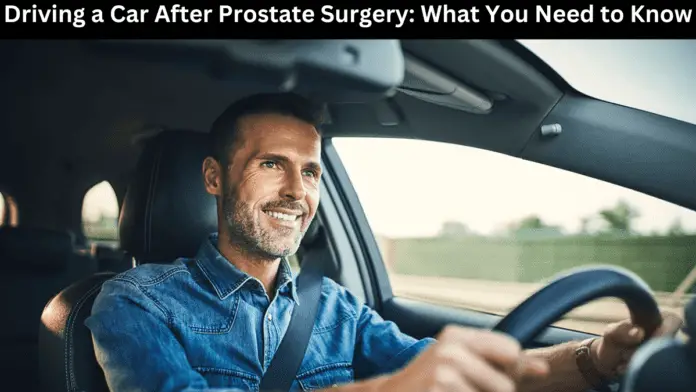
Prostate surgery is a common procedure for men, particularly as they age. One of the concerns that many patients have after undergoing this operation is when they can safely resume driving a car. In this comprehensive guide, we’ll explore everything you need to know about driving a car after prostate surgery, including the risks, precautions, and recommendations for a smooth recovery.
Understanding Prostate Surgery
Before discussing the specifics of driving a car after prostate surgery, it’s essential to understand the different types of prostate surgery and their potential impact on your recovery:
- Transurethral Resection of the Prostate (TURP): This is the most common type of prostate surgery, involving the removal of excess prostate tissue to alleviate urinary symptoms. The recovery time is generally shorter compared to other procedures.
- Prostatectomy: In this procedure, the entire prostate gland is removed. This is typically done to treat prostate cancer. Recovery can take longer and may involve more significant postoperative pain.
- Robotic-Assisted Laparoscopic Prostatectomy: This minimally invasive procedure uses robotic technology to remove the prostate gland. Patients often experience less pain and faster recovery times compared to a traditional prostatectomy.
Read: Is Oatmeal Good for Prostate?
Risks and Considerations
Driving a car after prostate surgery presents several risks and considerations that patients should be aware of:
- Pain and discomfort: Sitting in a car for extended periods can cause discomfort, particularly in the pelvic area. This may be exacerbated by the pressure of pressing the pedals while driving.
- Impaired reaction time: Pain medications taken during recovery may impair your cognitive abilities and reaction time, making it unsafe to drive.
- Limited mobility: Post-operative swelling and pain could limit your ability to move comfortably, potentially affecting your ability to control the vehicle.
- Risk of complications: Driving too soon after surgery may increase the risk of complications such as blood clots or infection.
When Can You Drive Again?
The timeline for driving a car after prostate surgery varies depending on the type of procedure, your overall health, and your surgeon’s recommendations. In general, patients can expect the following timelines:
- TURP: Most patients can resume driving within 1-2 weeks after surgery, provided they are no longer taking pain medications that impair their cognitive abilities.
- Prostatectomy and Robotic-Assisted Laparoscopic Prostatectomy: Patients undergoing these procedures may need to wait 2-4 weeks before resuming driving, depending on their individual recovery progress and the surgeon’s advice.
It’s essential to consult with your healthcare provider before getting behind the wheel to ensure you are physically and mentally ready for this activity.
Read: How Soon Can I Run After Prostate Surgery?
Precautions and Tips for Safe Driving
When you’re ready to start driving a car after prostate surgery, consider the following precautions and tips to ensure a safe and comfortable experience:
- Get clearance from your doctor: Always consult with your healthcare provider before resuming driving to ensure you are ready and not at risk for complications.
- Avoid long drives: Start with short trips and gradually increase the duration as your comfort and confidence improve.
- Use a cushion: Placing a cushion between your seat and the surgical area can help alleviate pressure and discomfort while driving.
- Stay well-hydrated: Adequate hydration can help reduce the risk of blood clots, which may be a concern during the recovery period.
- Take regular breaks: If you must embark on a longer drive, schedule regular breaks to stretch your legs and alleviate pressure on the surgical area.
Read: How Long Does Testosterone Injection Take to Work?
FAQs
Q: How soon can I drive a car after prostate surgery?
A: The timeline varies depending on the type of procedure, your overall health, and your surgeon’s recommendations. Generally, patients can resume driving within 1-2 weeks for TURP and 2-4 weeks for prostatectomy and robotic-assisted laparoscopic prostatectomy. Consult with your healthcare provider before resuming driving.
Q: What precautions should I take when driving after prostate surgery?
A: Some precautions include getting clearance from your doctor, avoiding long drives initially, using a cushion for added comfort, staying well-hydrated, and taking regular breaks during longer drives.
Q: Can pain medications affect my ability to drive safely after prostate surgery?
A: Yes, some pain medications taken during recovery can impair cognitive abilities and reaction time, making it unsafe to drive. It’s essential to consult with your healthcare provider before getting behind the wheel and ensure you are no longer taking medications that could affect your driving.
Q: What are the risks of driving too soon after prostate surgery?
A: Driving too soon after surgery may increase the risk of complications such as blood clots or infection. Additionally, pain and discomfort, impaired reaction time due to medications, and limited mobility could potentially affect your ability to control the vehicle safely.
Q: How can I make my car more comfortable for driving after prostate surgery?
A: To make your car more comfortable, consider using a cushion between your seat and the surgical area to alleviate pressure and discomfort. Also, adjust your seat position to provide optimal support and minimize strain on the pelvic region.
Conclusion
In conclusion, driving a car after prostate surgery requires careful consideration and consultation with your healthcare provider. By understanding the risks, precautions, and recommendations for a smooth recovery, you can safely resume driving and regain your independence. Remember to prioritize your health and well-being during this period and follow the advice of your medical professionals to ensure a successful and complication-free recovery.












